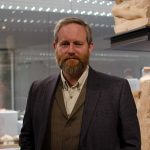Doktor Fred Hocker pracował jako praktykant w Mystic Seaport Museum, a następnie uzyskał tytuł licencjata z historii w Middlebury College w 1984 roku. Tytuł magistra historii otrzymał na Uniwersytecie Cambridge (1989 r.), natomiast doktorat z antropologii obronił na Uniwersytecie A & M w Teksasie (1991 r.). Od 1991 r. pracował na Uniwersytecie A & M w Teksasie, ucząc m.in. historii na temat średniowiecznego morskiego żeglarstwa i budowy statków. W latach 1994-1996 był prezesem Instytutu Archeologii Morskiej. Podczas pobytu w INA brał udział w wykopaliskach w Port Royal, a także w rekonstrukcji pozostałości kadłuba XI-wiecznego Serçe Limanı. Kierował dokumentacją XV-wiecznej kogi i XVII-wiecznego promu pasażerskiego w Holandii. Nadzorował pracami wykopaliskowymi slupów z XVIII wieku w Clydesdale na rzece Savannah w Południowej Karolinie i IX-wiecznego bizantyjskiego wraku w Bozburun w Turcji. W 1999 r. przeniósł się do Europy, aby zostać pełnoetatowym badaczem w Muzeum Archeologii Morskiej w duńskim Muzeum Narodowym w Roskilde, gdzie kierował opracowywaniem nowych technik dokumentacji i badań archeologicznych i wykopaliskami kogi z XII wieku w Kolding. Od 2003 r. jest dyrektorem ds. badań w Muzeum Vasa w Sztokholmie w Szwecji, gdzie odpowiada za kompleksową publikację wraku. W latach 2014-2015 był wizytującym archeologiem na Uniwersytecie w Cambridge. Jego zainteresowania naukowe koncentrują się na budownictwie okrętowym i ekonomii morskiej w średniowieczu i renesansie.
Uniwersytet Warszawski
Krakowskie Przedmieście 26/289 Lutego 2019
Zarezerwuj swój czasGoście z całego świata
Prezentacje i warsztatyPonad 300 nurków gości
Kup bilet terazPrelegent

Dr. Fred Hocker served as a shipwright’s apprentice at Mystic Seaport Museum before completing a BA in history at Middlebury College in 1984. He furthered his education with a diploma in history from Cambridge (1989) and a PhD in anthropology from Texas A&M University (1991). He was employed as the Yamini Faculty Fellow and then Yamini Associate Professor of Nautical Archaeology at Texas A&M from 1991, teaching medieval maritime seafaring and the history of shipbuilding. From 1994-1996 he served as the president of the Institute of Nautical Archaeology. While with INA, he participated in the Port Royal excavation and the reconstruction of the 11th-century Serçe Limanı hull remains, and directed the recording of a 15th-century cog and a 17th-century passenger ferry in the Netherlands, the excavation of an 18th-century pilot sloop at Clydesdale Plantation on the Savannah River in South Carolina, and the excavation of the 9th-century Byzantine shipwreck at Bozburun, Turkey. In 1999 he moved to Europe to be a full-time senior researcher at the National Museum of Denmark Centre for Maritime Archaeology in Roskilde, where he led development of new techniques for archaeological documentation and research and directed the excavation of a 12th-century cog at Kolding. Since 2003 he has been the Director of Research at the Vasa Museum in Stockholm, Sweden, where he is responsible for the comprehensive publication of the find. In 2014-2015 he was a visiting fellow in archaeology at Cambridge University. His research interests focus on shipbuilding and maritime economics in the Middle Ages and Renaissance.
Web links:
Dr. Fred Hocker served as a shipwright’s apprentice at Mystic Seaport Museum before completing a BA in history at Middlebury College in 1984. He furthered his education with a diploma in history from Cambridge (1989) and a PhD in anthropology from Texas A&M University (1991). He was employed as the Yamini Faculty Fellow and then Yamini Associate Professor of Nautical Archaeology at Texas A&M from 1991, teaching medieval maritime seafaring and the history of shipbuilding. From 1994-1996 he served as the president of the Institute of Nautical Archaeology. While with INA, he participated in the Port Royal excavation and the reconstruction of the 11th-century Serçe Limanı hull remains, and directed the recording of a 15th-century cog and a 17th-century passenger ferry in the Netherlands, the excavation of an 18th-century pilot sloop at Clydesdale Plantation on the Savannah River in South Carolina, and the excavation of the 9th-century Byzantine shipwreck at Bozburun, Turkey. In 1999 he moved to Europe to be a full-time senior researcher at the National Museum of Denmark Centre for Maritime Archaeology in Roskilde, where he led development of new techniques for archaeological documentation and research and directed the excavation of a 12th-century cog at Kolding. Since 2003 he has been the Director of Research at the Vasa Museum in Stockholm, Sweden, where he is responsible for the comprehensive publication of the find. In 2014-2015 he was a visiting fellow in archaeology at Cambridge University. His research interests focus on shipbuilding and maritime economics in the Middle Ages and Renaissance.
Web links: